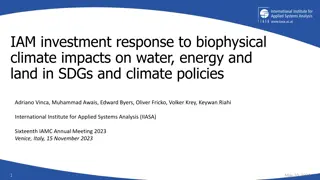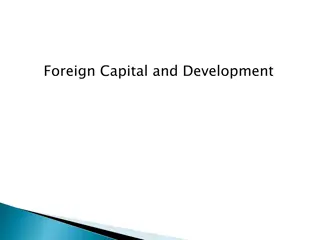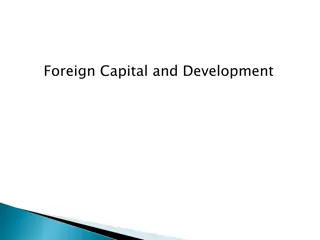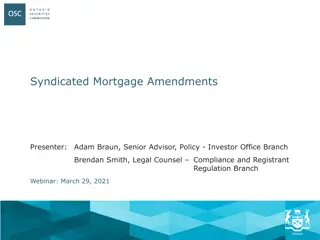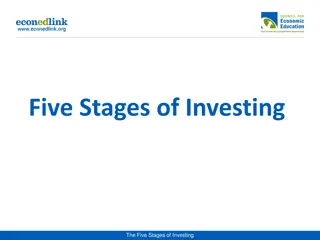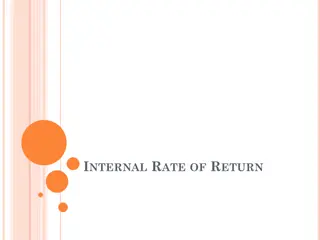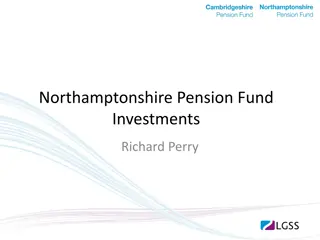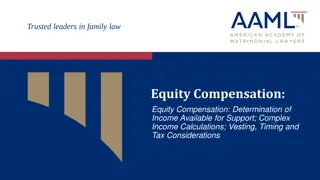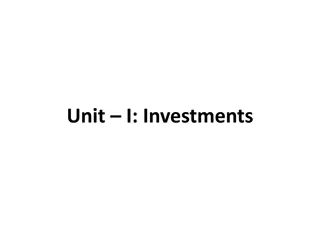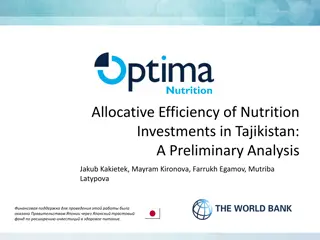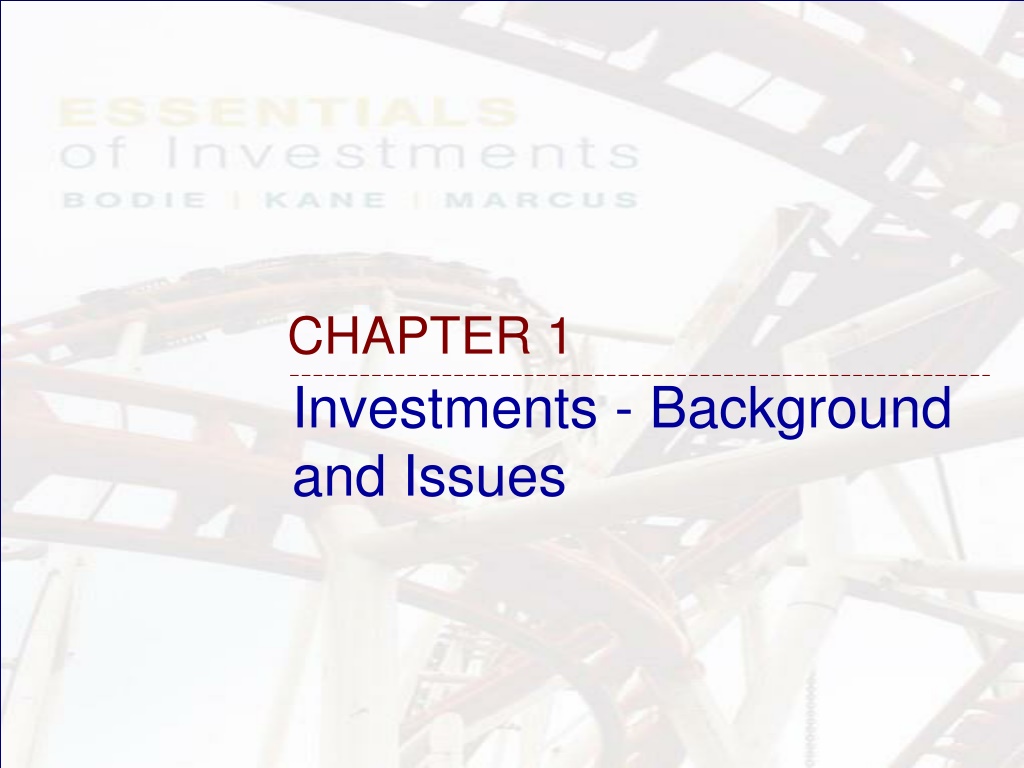
Investments - Background and Key Issues
Delve into the foundational aspects and critical challenges surrounding investments. Explore essential concepts, historical perspectives, and current issues shaping the investment landscape.
Download Presentation

Please find below an Image/Link to download the presentation.
The content on the website is provided AS IS for your information and personal use only. It may not be sold, licensed, or shared on other websites without obtaining consent from the author. If you encounter any issues during the download, it is possible that the publisher has removed the file from their server.
You are allowed to download the files provided on this website for personal or commercial use, subject to the condition that they are used lawfully. All files are the property of their respective owners.
The content on the website is provided AS IS for your information and personal use only. It may not be sold, licensed, or shared on other websites without obtaining consent from the author.
E N D
Presentation Transcript
CHAPTER 1 Investments - Background and Issues
Learning Goals of Chapter 1 This chapter takes an overview of what we will learn in the text book Defining an investment ( ) Investment targets: financial or real assets ( ) Different classes of financial assets (Ch 2 and Parts 3, 4, and 5) Roles of financial markets (Ch 3) Corporate governance ( ) Investment process Risk-return trade-off and efficient markets (Part 2) Players and innovations in financial markets (Ch 4) Financial crisis in 2008 1-2
1.1 REAL ASSETS VERSUS FINANCIAL ASSETS 1-3
Financial Versus Real Assets Real Assets (tangible ( ) or intangible ( )) Assets used to produce goods and services, e.g., land, buildings, equipment, inventory, or patents Can generate net income to the economy Financial Assets Claims ( ) on real assets or the income generated by them, e.g., equity shares or debt of firms Essence of investment: sacrifice something now, invest in real assets or financial assets, and expect to benefit from that sacrifice later Focus on investing in financial assets in the course Goal of smoothing consumption: invest in good time periods, and realize investments when you need more consumption 1-4
Balance Sheet () of U.S. Households 2022 The largest parts of assets and liabilities both come from the house owned The position of deposits is usually maintained for liquidity of consumption Pension reserves ( ) is the money or assets invested for future retired life Equity in noncorporate business may come from the investment in sole proprietorship ( ) or partnership companies ( ) 1-5
Financial Versus Real Assets Net worth of the economy = Sum of real assets Financial assets and liabilities must balance over all households, firms, and banks Banks account, corporate stock, or corporate bonds are not only financial assets of households but also the liabilities of the issuers Banks use the proceeds of deposits to lend to firms or households or to buy some financial asset issued by firms Firms issue financial assets (e.g., corporate stock or bonds) to pay for the acquirement of real assets For the aggregated balance sheet, only real assets remain as the net worth of the economy 1-6
1.2 A CLASSIFICATION OF FINANCIAL ASSETS 1-8
Major Classes of Financial Assets Debt (fixed income securities) (Part 3: Debt Securities) Pay a specified cash flow over a specific period Money market instruments ( ) (shorter term (< 1 yr.), lower risk), e.g., Treasury bills ( ) Capital market instruments ( ) (longer term (> 1 yr.), higher risk), e.g., Treasury or Corporate Bonds ( ) Equity (Part 4: Security Analysis) An ownership share in a corporation Shareholders may receive dividends ( ) and have prorated ownership in the real assets of the firm 1-9
Major Classes of Financial Assets Derivative securities (Part 5: Derivative Markets) Securities providing payoffs that depend on the values of other assets Futures ( ): an agreement (with both right and obligation) to buy or sell an asset at a certain time point in the future for an agreed price Options ( ): a right to buy or sell an asset at a certain time point in the future for a specified price See the introduction on Slide 2-49 1-10
1.3 FINANCIAL MARKETS AND THE ECONOMY 1-11
Financial Markets Provide (price) information Market prices, determined by demand and supply, reflect the consensus ( ) of investing public While market prices are determined, capital resources are allocated ( ) efficiently For firms with good (poor) prospects, the stock market encourages (discourage) allocation of capital to those firms, whose share prices are bidden up (down) Free market competition vs. Central planner Shift consumption timing for individual investors Shift your purchasing power from high-earnings periods to low-earnings periods of life Ultimate goal of investment for individual investors is to smooth their consumption over lifetime 1-12
Financial Markets Allocate risk ( ) Firms can transfer the project risk to investors who buy stock shares or bonds issued by the firms Allow investors with the greatest taste for risk to bear that risk Stock shares desired by more risk-tolerant investors Bonds desired by more conservative investors Another benefit for firms to raise funds When investors are able to select security types with the risk-return characteristics that best fit their preference from the financial markets, each security can be sold at the best possible price 1-13
Financial Markets Separate ownership with management Invention of stock shares and stock markets allows the separation of ownership and management Meanwhile, shareholders elect a board of directors ( ) to supervise the management of the firm Advantages for this arrangement Firms existence or performance is independent of the status of their shareholders Can hire professional managers to operate the firm Shareholders can sell shares to others in financial markets without affecting the management 1-14
Financial Markets Agency problems ( ): Conflicts of interest between managers and shareholders Managers (shareholders) care about salary (equity value) Examples: empire building (via excessive growth or investment), avoid risky projects, or overconsume luxuries These suboptimal decisions hurt interests of shareholders Solutions: Performance-based compensation plans (link the manager s income with the performance of the stock price) Penalty for the poor performance in stock price (force out or fire the manager) Specialist monitoring (analysts, fund managers, or banks) Threat of takeovers ( ) by other firms (enhance the firm value by replacing poor-performing managers) 1-15
Corporate Governance and Ethics What is corporate governance ( )? Corporate governance is the set of processes, policies, or institutional systems affecting how a corporation is directed, administered, or controlled Associated with interests among all stakeholders ( ), including shareholders, debtholders, employees, customers, and communities in which firms operate Arises from the information asymmetry among stakeholders Without trust among stakeholders, additional laws and regulations are required Generally designed to protect the investing public, who possess less information and control power for firms Build the confidence of the investing public, which is the essential pillar to support financial markets 1-16
Poor Corporate Governance Accounting scandals ( ) (Enron, WorldCom, Rite-Aid, HealthSouth, etc.) Enron in 2001 In late 2001, Enron was one of the world's leading electricity, natural gas, communications and pulp and paper companies, with claimed revenues of nearly $101 billion in 2000 Using special purpose entities (SPEs) (also known as special purpose vehicle (SPV)) to hide debt which should be in its own books (by selling non-performing assets to SPEs) WorldCom in 2002 The U.S. second largest long distance phone company (after AT&T) Classify expenses as investments to enhance net income or even hide losses 1-17
Poor Corporate Governance Misleading research reports by stock analysts (Citibank, Merrill Lynch, etc.) Instead of providing fair reports, their favorable reports are traded for the promise of future investment banking business for the firm, e.g., participating the allocation of public offerings ( ) Auditors ( ): watchdogs or consultants Example of Arthur Andersen (AA) in Enron case: due to the fact that the profit from consulting is higher than that from auditing, AA, in order to protect its consulting profits, had to weak its function of auditing 1-18
Reform of Corporate Governance Sarbanes-Oxley Act in 2002 (tightening the rules of corporate governance in the U.S.) Requiring more independent directors ( ), who are not affiliated with the company or its subsidiary companies, in boards of directors CFOs ( ) need to personally vouch ( ) for the truth of corporate accounting statements A new quasi-public agency, Public Company Accounting Oversight Board, is created to monitor the accounting/auditing industry Prohibit an auditor from providing various other services for the same client 1-19
Stakeholder Capitalism and ESG Investing Stakeholder capitalism ( ) Firms need to recognize and address ethical and societal considerations beyond their private pursuit of profit, e.g., spending more on pollution reduction Stakeholder capitalism vs. Shareholder capitalism ESG investing Accounting for environmental (E), social (S), and governance (G) characteristics of firm s when making investment decisions Advocates believe that sustainable investment strategies compatible with a healthier and more resilient economy in the future leads to long-term value maximization Almost impossible to make decisions for long-term goals 1-20
Stakeholder Capitalism and ESG Investing Skeptics respond that if that were true, firms would pursue these policy on their own without the need for encouragement from outsiders Almost impossible to reconcile conflicting objectives; non-value-maximizing strategies even run the risk that competitors may force firms out of business So far, little evidence show that ESG investing delivers higher returns Greenwashing: firms claim to follow ESG (or even rebrand existing funds with ESG-related names) but not actually do ESG-related activities No commonly accepted definition of EST ESG-related funds (products) may charge more management fees (attract customers and sell at higher prices) 1-21
Investment Philosophies and Strategies Asset allocation ( ) Choice among a broad classes of assets Decide weights of various classes of assets 1. According to your return-risk preference ( ) 2. According to the portfolio theory: constructing a well- diversified ( ) portfolio to generate the desired expected return but bear lower degree of risk Correlations between assets affect the portfolio risk Top down strategy ( ) The investment portfolio is constructed starting with asset allocation For example, deposits vs. securities, stocks vs. bonds, automobile industry vs. electronic industry, Treasury bills vs. Treasury bonds, and so on 1-23
Investment Philosophies and Strategies Security selection ( ) Perform the security analysis to evaluate securities and find over- or under-valued ones Bottom up strategy ( ) Find securities with over- or under-estimated prices but ignore the resulting asset allocation In an efficient market ( ) Price distortions exist for a very short time period because many investors try to benefit from selling overvalued and buying undervalued securities Theoretically, there are almost no distorted-price securities and the bottom up strategy is difficult to make profit 1-24
1.5 MARKETS ARE COMPETITIVE AND RISK-RETURN TRADE-OFF 1-25
Financial Markets are Competitive Performance in financial markets is measured solely by gains or losses in money This unique characteristic causes that the only criteria for selecting securities are high expected returns and low riskiness The pursuance for those securities makes financial markets extremely competitive Another source of competition: Many well-trained or knowledgeable investors constantly survey the financial market for the best buys (the most underpriced securities) 1-26
Risk-Return Trade-Off () Assets with higher expected returns have greater risk (risk-return trade-off) Consequence of market competition and traders risk averse attitude If traders buy the high-return-low-risk assets, asset prices will rise and the expected returns (=expected payoff/price - 1) are lowered until the expected returns are commensurate ( ) with risk As a result, you want higher expected returns you need to bear higher investment risks Stocks: high average annual return (12%) and high degree of risk (min: 46% and max: 55% for one year) Bonds: low average annual return (<6%) and low degree of risk (never lose more than 13% in any one year) 1-27
Risk-Return Trade-Off () What role does diversification ( ) play Diversification means reducing risk by investing in a variety of assets ( ) Diversification can reduce the risk of the portfolio without hurting too much the expected return of the portfolio ( ) The effect of portfolio diversification, the proper measurement of risk, and the risk-return relationship are the topics in modern portfolio theory and will be mentioned in Part 2: Portfolio Theory 1-28
Efficient Markets Theory In an efficient market ( ), security price should reflect all information available to traders concerning the value of the security A market can be further classified as weak-form, semistrong-form, and strong-form efficient market ( ) (discussed in Chapter 8) The price of the security in an efficient market adjusts quickly to reflect the new information, i.e., there would be neither underpriced nor overpriced securities in an efficient market theoretically (discussed in Chapter 8) 1-29
Active Versus Passive Management Whether we believe markets are efficient affects our choice of appropriate investment management style Active management ( ) (in inefficient markets) Find undervalued securities by fundamental analysis Market timing strategy: to develop strategies based on the prediction of future market movement by technical analysis Passive management ( ) (in efficient markets) No attempt to find distorted-price securities No attempt to time the market Holding a well-diversified portfolio 1-30
1.6 THE PLAYERS 1-31
The Players Five major players in financial markets Business firms ( ) net borrowers (raising funds by issuing stocks or bonds) Households ( ) net savers Government ( ) can be either net borrower or net saver (depending on tax revenue and government expenditures) tax revenue > government expenditures net saver tax revenue < government expenditures issuing Treasury bonds to raise money net borrower Financial institutions and financial intermediaries ( ) Investment banks ( ) 1-32
The Players Financial institutions and financial intermediaries They both are institutions that connect borrowers and lenders by accepting funds from lenders and loaning funds to borrowers Their social function is to channel household savings to business sectors ( ) For financial institutions (e.g., commercial and investment banks, insurance companies), they can make profit by 1) taking risk; 2) providing service The next two slides show significant differences between the balance sheets of nonfinancial business and financial institutions For financial intermediaries (e.g., investment companies, mutual funds, pension funds, hedge funds), they only provide service and thus earn fees 1-33
Balance Sheet of Nonfinancial U.S. Business Firms 1-34
Balance Sheet of Commercial Banks () Financial institutions earn interest rate spreads at the expense of suffering default risk ( ) of business firms Financial institutions are usually with a high percentage level of liability, which can increase the rate of return for shareholders substantially Default risk of financial institutions is high, so they need rigorous risk management systems 1-35
The Players Why financial institutions or intermediaries (FIs) exist? 1. It is comparatively inefficient for small-size households to make direct investment ( ) Higher transaction cost ( ) No economic scale ( ) to manage portfolios or survey markets Difficult to achieve diversification ( ) for small-size portfolios FIs pool sources of small investors and lend considerable amounts to firms or conduct large-scale trading 2. For households (net savers), it is also difficult to find borrowers by themselves 3. An individual lender is difficult to estimate and monitor the default risk ( ) of borrowers In addition to developing lending policies that suit themselves, FIs also diversify default risks by lending to many borrowers Due to economies of scale, FIs can build expertise to manage portfolios and various types of risks ( ) 1-36
The Players Investment banks ( ) (introduced in Ch. 3) Financial institutions specializing in the sale of new securities to the public, typically by underwriting ( ) the issue Firms do not directly market their securities to the public. Instead, they hire investment bankers to represent them to the investing public Primary market ( ): a market in which new issues of securities are offered to the public Players: business firms, investment bankers, and institutional or individual investors Secondary market ( ): preexisting securities are traded among investors Players: institutional and individual investors 1-37
The Players Commercial and investment banks functions were separated by laws in the U.S. from 1933 to 1999 Glass-Steagall Act in 1933: Prohibited banks from both accepting retail deposits ( ) and underwriting securities ( ) Commercial banks accept deposits Investment banks neither accept deposits nor undertake the business of retail loans ( ) Investment banks raise funds through issuing corporate bonds ( ) or borrowing money from other financial institutions Gramm-Leach-Bliley Act (Financial Services Modernization Act) in 1999: allowed commercial banks, investment banks, securities firms, and insurance companies to consolidate to form financial holding companies ( ) Large investment banks still operated independently from commercial banks, but many large commercial banks increased their investment banking activities, pressuring profit margins of traditional investment banks 1-38
The Players Money invested to finance a new firm is called venture capital ( ) A start-up company relies on bank loans and investors who are willing to stake ( ) on the future of this small and young companies Note that smaller and younger companies do not have options to issue publicly-traded securities for raising funds Two sources of venture capital: venture capital funds ( ) or wealthy individuals known as angel investors( ) Venture capital funds and angel investors usually engage in the operation of the invested company, e.g., help to recruit managers or provides business advice 1-39
The Players In practice, there are a lot of fails for venture capital investments, but a successful case can bring million profits These investments in firms that do not trade on public stock exchanges are known as private equity investment ( ) 1-40
The Players Fintech and Financial Innovation: Fintech, the application of technology to financial markets, has changed financial landscape Technology (via Internet) trend is disintermediation ( ) and decentralization ( ) Peer-to-peer lending link lenders and borrowers directly, without need of an intermediary like a commercial bank Cryptocurrencies ( ) such as Bitcoin or Ethereum allow for payment systems bypassing traditional channels Based on blockchain ( ) technology Anonymity, distributed and publicly record keeping (no single target for potential hackers to attack) Transaction validation is now time- and energy-consuming 1-41
The Players Digital currency is a cryptocurrency issued by the central bank of a sovereign ( ) government China is running trials of a digital yuan and Fed would study the feasibility of a digital currency in the U.S. Questions: security, privacy, and government access to financial activity Digital token is a cryptocurrency issued in an Initial Coin Offering (ICO) ICO is a source of crowdfunding ( ) in which firms raise funds by issuing digital tokens ( ) The coins can be used to purchase products or services from the issuing firm The coins can be traded among investors Although firms do not sell their equity or debt via ICO, some argued that these coins are in fact securities issued by firm and should be subject to SEC regulation China and South Korea have banned ICOs 1-42
Securitization () Pooling loans and backed by those loans, issue standardized securities, which can then be traded like any other securities Payments from loan borrowers will pass to holders of securitization securities, rather than the originating bank ( ) Holders of securitization securities can earn the average lending rate minus the fee paid to the initiating bank Lending rate can be decomposed into two parts, compensating default risk and funding cost, respectively The ownership and default risk of loans are also transferred to holders of securitization securities Initiating banks sometimes purchase part of securitization securities back for themselves 1-44
Securitization () Increase the asset liquidity ( ) by replacing the illiquid loan assets with liquid securitization securities Securitization securities vs. original loans Securitization securities (originate to distribute) Small, standard size Credit risk ( ) is transferred to holders of the securitization securities Holders of the securitization securities can earn (the average lending rate the fee paid to the initiating bank) Predictable default rates for portfolios of loans (due to the diversification effect) Perceivable degree of the credit risk for holders of securitization securities Liquid assets: tradable in public markets Original loans (originate to hold) Large, nonstandard size The bank which lends the loan bears the credit risk The bank can earn the spread between the lending rate and funding cost Uncertain default rate for each loan Lenders are difficult to estimate accurately the credit risk of a single loan Illiquid assets: sizes and periods of loans and information asymmetry (moral hazard ( )) hinder selling loan assets to others 1-45
Mortgage-Backed Securities Mortgage Loan ( ) and Mortgage- Backed Security (MBS, ) A mortgage loan ( ) is a loan with the real properties ( ) as the collateral ( ) A MBS, which is the security generated from the securitization process, represents the ownership of a pool of mortgages loans In 1970s, Fannie Mae (FNMA, ) and Freddie Mac (FHLMC, ), government-sponsored institutions, guarantee the timely payment of principal and interest ( ) even if the borrowers default and then issue MBSs based on portfolios of these loans The simplest type of the mortgage-backed securities is the pass-through ( ) MBSs The intermediaries (banks and FNMA or FHLMC) collects the monthly payments from household borrowers, and after deducting a fee, passes the cash flows to holders of the pass- through MBSs 1-46
Financial Crisis in 2008 Traditionally all MBSs were based on conforming mortgage loans ( ), but since 2006, Alt-A and subprime mortgage loans ( ) were included in pools Prime (or A-paper) mortgages are conforming or conventional loans, meaning it would meet the guarantee requirement and can be resale to government-sponsored institutions (like FNMA and FHLMC) The Alt-A loans are still with low risk, but for some reasons are not initially conforming, e.g., the size is too large or the required documents are not complete Subprime mortgage loans reflect borrowers who do not meet the underwriting criteria (e.g., loans / house value < 80% or monthly payment / monthly income < 35%) and have a high perceived risk of default (Note that subprime mortgage loans are commonly arranged as adjustable-rate mortgages (ARM) ( )) 1-47
Financial Crisis in 2008 The reasons for the growth of the subprime mortgage loans The growing house prices The low interest rate to aid the U.S. economy in its recovery from the 2000-2001 recession reduces the overall interest rate paid by the subprime borrowers Political encouragement to spur affordable housing led to increase in subprime lending 1-48
Financial Crisis in 2008 Subprime crisis ( ): Financial institutions assumed housing prices would continue to rise, but they began to fall rapidly since 2007 The interest rate rises from 2004 to 2007, which increases the payment burden of subprime borrowers Consequently, MBSs backed with subprime mortgage loans, widely held by financial institutions, lost most of their value due to defaults of subprime borrowers The result has been a large loss in the capital of many banks worldwide and U.S. government sponsored institutions (like FNMA and FHLMC) Note that MBSs play the role of the transmission media to spread this crisis worldwide spillover effects ( ) from U.S. markets to other foreign markets This is also the reason for the name of financial tsunami ( ) 1-49
Financial Crisis in 2008 Collateralized debt obligation (CDO, ) CDO is a type of structured asset-backed security, which concentrate the default risk of loans onto one or two tranches ( slices ) of investors CDOs create high rating securities from the pools even with a high degree of default risk (However, it does not work in a widespread downturn) Credit default swaps (CDS, ) The CDS is an insurance contract against the default of the reference entity AIG (American International Group, a multinational insurance corporation) sold $400 billion in CDSs and it is one of the reasons to result in its default CDOs and CDSs further encourage the spread of (subprime) MBSs over the world Both CDOs and CDSs will be discussed in Ch. 10 1-50


